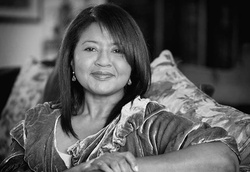“Are there any continuities,” wonders scholar Min Hyoung Song, “between the earlier generation of writers which first raised the banner of an Asian American literature and a later generation of writers which inherited it?” The Asian American Literary Review asked writers to respond to this question for their Spring 2012 issue on “Generations.”
Forum Response by Velina Hasu Houston
Respecting History
As a playwright of Asian descent, I find my perspectives on Asian American literature naturally gravitate toward Asian American dramatic literature. As early as the 1920s, Asian American playwriting emerged with Gladys Li’s The Submission of Rose Moy (1924).1 In the early phase, other Asian American women wrote for the stage from that period through 1959, such as Wai Chee Chun, Bessie Toishigawa, and Patsy Saiki.2 After the 1960s, the playwrights often referred to as the “first wave” emerged, including Frank Chin, Wakako Yamauchi, Edward Sakamoto, Momoko Iko, Linda Faigao-Hall, Jude Narita, Perry Miyake, and Genny Lim.
This was followed by a second wave that included David Henry Hwang, Elizabeth Wong, Philip Kan Gotanda, Jeannie Barroga, Jessica Hagedorn, Cherylene Lee, Alberto Isaac, Henry Ong, C.Y. Lee, Karen Huie, Perry Miyake, Amy Hill, Jon Shirota, Cynthia Gates-Fujikawa, Denise Uyehara, Dan Kwong, Shishir Kurup, and others. I think of my work as falling between the second and third waves and therefore across their borders (which is indicative of my transnational life in general). When I moved to Los Angeles, I was a new entry in a field that already included the writers known as second wave.
The third wave includes such writers as Chay Yew, Naomi Iizuka, Diana Son, Ken Narasaki, Sung Rno, Julie Cho, Prince Gomolvilas, Aditi Kapil, and others. Shall we say that the fourth wave has begun and includes such voices as Boni B. Alvarez, Shane Sakhrani, Lily Ling Wong, Mayank Keshaviah, Reme Grefalda, Weiko Lin, Kristina Wong, Esther K. Chae, Jeanne Sakata, Jamil Khoury, Lina Patel, Annette Lee, Janine Salinas, Jesse Shao, Michael Premsrirat, Madhuri Shekar, Nahal Navidar, Yussef El Guindi, Kemba Saran, and others?
Sources and Reasons for Writing
I know there are many names missing from my recapitulations, and that, in essence, is a good thing because it illustrates that the number of playwrights of Asian descent in the U.S. has grown to a point that one cannot recount their names effortlessly. It speaks volumes for the legacy of Asian American creative writers and the new Asian American writers that enter the field in impressive numbers as time goes by. I characterize the field genuinely. From the names that I mention, it is clear that I do not limit my view of Asia to the Far East. In addition, I am cognizant that West, Central, Southeast, and South Asian heritage must be embraced in the notion of an Asian American identity.
I am not certain if the fourth-wave playwrights inherited a literary legacy from the pre-first-wave or first-wave playwrights and, if they did, I would hazard to guess that they are not fully aware of that fact. I think it is true that as dramatizations of Asian or Asian American stories became more prevalent on U.S. stages, it made it easier for future Asian American playwrights to bring their works to those stages. I also know, however, that the processes of selection that bring any play to any stage in the US are complicated labyrinths, the outcomes of which can never be said to be (at least entirely) connected to ethnicity (or gender). It is an intricate political and often socioeconomic subjective jumble that brings the play from the page to the stage, and the larger the stage, the more complex the jumble.
Above all, it is important to note that artists and their muses are a unique state of affairs. This, in fact, may be the sole arena of continuity that is shared by all waves of Asian American playwrights. Writers write out of singular passions that are individual to each writer. What motivates or inspires one writer is usually different from what motivates or inspires another writer. And if the motivation or inspiration happens to be the same, the plays that emerge from them will not be. Why we write what we write is a curious matter that cannot be simply defined, deconstructed, or categorized.
For instance, people often ask me why I am interested in transnational East-West themes. It is not the themes that interest me. It is simply that I often (but not always) write from that point of view because it is my heritage, just as Russian perspectives interested Anton Chekhov, Irish American ones interested Eugene O’Neill, African American ones interested August Wilson, and Southern Jewish ones interest Alfred Uhry. I am absolutely sure that fourth-wave Asian American playwrights share a connection with Gladys Li: their muses compel them towards certain stories that are unique to their own experiences, ideologies, and imagination. The fact that they are all of Asian descent may have less to do with continuity than the creative compulsions that drive writers in general do.
A Diverse Continuum
Even so, however, I find that many emerging Asian American playwrights are interested in themes that have some connectivity to their ethnic heritages or to other Asian or Asian-descent heritages. If they are transnational like me, I also observe that they are interested in the East-West or some other cross cultural milieu and the conflicts and collusions that breed within them. When I talk with these writers about it, however, they express their commitments to such environments as if they are new notions that have never been broached before. This indicates to me that their impulses are fresh and innate to their beings, not necessarily inspired by writers who came before them.
Perhaps earlier playwrights’ successes helped theatres to begin to consider the Asian American experience as a valid one to explore on U.S. stages, but above and beyond that, Asian American playwrights wrote and write driven by their own particular desires and will continue to do so. Central to this nurturing of an Asian American or, in my case, transnational consciousness is the fact that many first-, second-, and third-wave Asian American playwrights continue to contribute powerful plays that are being produced in mainstream theatres around the globe. A diverse continuum is necessary to cultivate literature in general and, in particular, Asian American literature.
It is probable that U.S. theatre was not ready to embrace the Asian American voice historically and, in many respects, still finds it foreign to the American mainstream. Often when Americans think about the notion of race, they think in black-white bipolarisms that maintain what is Asian American as, at best, an anomaly. This can work in one’s favor or against it when one is hoping for a theatre to produce one’s work or when one is selecting a play to see. It can be anomalous to the point that it offers a refreshingly different point of view or it can be anomalous to the point that one, if you will, does not patronize that restaurant. On the positive side, what headway Asian American playwrights have made has raised the consciousness of many spectators and cultural producers so that successive generations may find it easier to get a foot or leg or torso in the door. Theatres are still learning to embrace the Asian American consciousness, but at least the learning is in progress, and that is a victory. To quote The Beatles, “It’s getting better all the time.”
I find it exhilarating to see new voices of Asian descent contributing to the field, despite the fact that many emerging playwrights continue to struggle to overcome the speed bumps of their stories being seen as too different or foreign by the U.S. mainstream. There are of course sundry exceptions to that rule, and it is true that playwrights of any hue or ethnicity may find it hard to be produced in an increasingly fiscally driven production environment. The hill, however, can often be harder to climb for playwrights of Asian descent, particularly for females of Asian descent.
The sheer number of playwrights of Asian descent writing for global stages is an embarrassment of riches and surely an indication that the field is expanding brilliantly, gradually becoming an innate part of the global literary environment—which it always was.
*The Velina Hasu Houston Collection is part of the APA Playwrights Series in the Library of Congress, housed in the Asian Division’s AAPI Collection. For inquiries, email regr@loc.gov.
Notes:
1. Unbroken Thread: An Anthology of Plays by Asian American Women. Ed. Roberta Uno. University of Massachusetts Press, 1993. 5.
2. Ibid.
Next Forum response will be by Anna Kazumi Stahl >>
*This article was first published in The Asian American Literary Review Spring 2012: Generations. The AALR has generously shared several of the forum responses, poetry, and prose with Discover Nikkei from this issue by David Mura, Richard Oyama, Velina Hasu Houston, Anna Kazumi Stahl, Amy Uyematsu, and Hiromi Itō (translated by Jeffrey Angles).
AALR is a not-for-profit literary arts organization. To learn more about it or purchase a subscription to the journal, visit online at www.asianamericanliteraryreview.org, or find them on Facebook.
© 2012 Velina Hasu Houston




